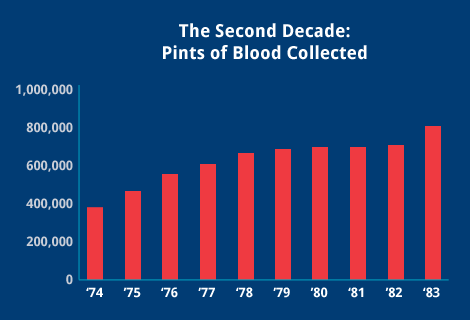1974 - 1983
During NYBC’s second decade, the VCR was invented and the world was captivated by Star Wars. We began developing specialized services to meet hospital and patient needs.

- 1974
- NYBC organized into five areas: Blood, Blood Derivatives, Research, Transplantation, and Education (and central administrative services).
- NYBC adds a second “Groupamatic 360” to further expand testing and improve safety.
- 70 Research Grants bring in $3.25 million dollars for projects.
- NYBC’s First Vice President, Lindsley Fiske Kimball, is honored as the Research Institute is named for his efforts.
- 1976
- Euroblood units contribute 199,328 units to the total 619,990 units collected with nearly 300 hospitals served by NYBC.
- BLOODNET, one of the first computer programs for testing, labeling, storing and shipping blood, is established as a joint venture between the blood program and the Operations Research Laboratory (Eric Brodheim working with Dr. Fred Allen).
- 90 research papers are published including important studies by Pablo Rubinstein, MD of the Laboratory of Immunogenetics and Wolf Szmuness, MD of the Laboratory of Epidemiology.
- 1977
- NYBC officially changes its name from Community Blood Council of Greater New York to New York Blood Center.
- NYBC’s single donor cytopheresis program (for separating platelets and white cells while returning plasma and red cells to the donor) expands to over 3,000 volunteer donors typed for HLA antigens on their white blood cells and platelets.
- NYBC’s Blood Derivatives Program processes a record 53,741 liters of plasma for clinical use in area hospitals.
- 1978
- NYBC licenses the first low cost HBV (Hepatitis B) vaccine, a technology developed by Dr. Alfred Prince and the staff of the Laboratory of Virology. Over 75 million low cost doses produced for public sector immunization prevent an estimated 1 million cases of liver cancer.
- 1979
- NYBC completes financing of the expansion of its Melville Laboratories with a $12.5 million dollar privately placed bond issue with the Dormitory Authority of New York State.
- NYBC signs a long term agreement for the preparation of blood plasma derivatives with the American Red Cross.
- NYBC pioneers use of bar-coding in blood banking operations, now standard throughout the world in reducing possibility of human error and speeding blood product processing.
- 1980
- Facility for production of plasma derivatives opens as part of NYBC’s Long Island Blood Services operation, and annual production capacity increases from 60,000 liters to 300,000 liters along with preparation of new plasma products with therapeutic potential.
- NYBC’s Derivatives Program receives a $976,000 grant by the National Heart, Lung and Blood Institute for a three year study of the investigative drug Interferon.
- 1981
- Blood usage increasing at a rate of approximately 5% per year largely due to advances in medicine and surgery and the aging of the population.
- NYBC’s first volunteer blood donor campaign (headed by NYBC’s Chairman of the Board, at the time also President of Citibank, the late William Spencer) achieves a first year increase of 7% in collections and produces a record 260,000 platelets primarily for treating cancer patients.
- NYBC’s Blood Program is first to create the Cell Isolation and Analysis Laboratory with a fluorescence activated cell sorter to separate, classify and study blood lymphocytes.
- 1982
- Blood Collections include 246,434 units from Euroblood of the 716,709 total collected. New York Blood Services collected 30% while Long Island Blood Services collected 17%, New Jersey Blood Services collected 10% and Hudson Valley Blood Services collected 9% of the total.
- Dr. Cladd Stevens begins AIDS research project while Dr. Pablo Rubinstein studies changes in the immune system of AIDS patients with Kaposi’s sarcoma.
- Drs. Prince, Neurath and Horowitz begin studies on the inactivation of viruses.
- 1983
- NYBC pioneers a Home Care Convenience Kit for hemophilia patients containing coagulation materials and self administration equipment. Today in cooperation with the Hemophilia Consortium, NYBC’s Hemophilia Services division has provided products and services to over 50,000 patients - locally and regionally.
- 1975
- Lindsley F. Kimball Research Institute increases staff significantly to 140 including 46 doctoral level scientists.
- NYBC Education Department develops first Blood Bank Directors Training Program for physicians along with Technician Training Program for licensed technicians and Summer Research Fellowship Program for college students.
- NYBC organizes the first LC Dunn Lecture Series in honor of the late Columbia University Professor who was one of the world’s leading geneticists and a charter member of NYBC’s Community Blood Council Scientific Council.
